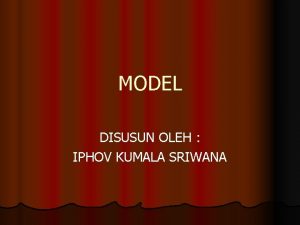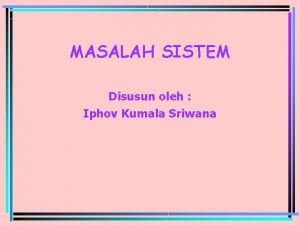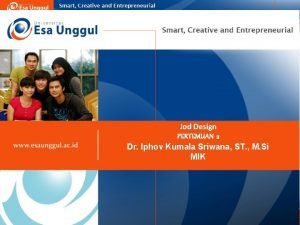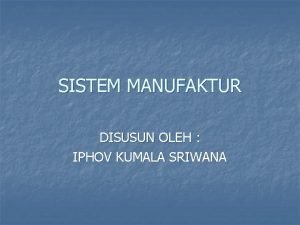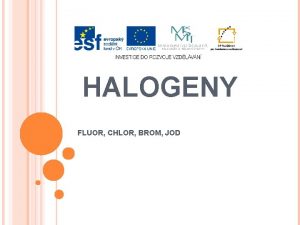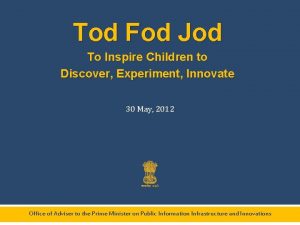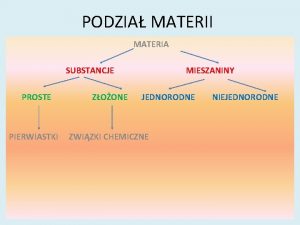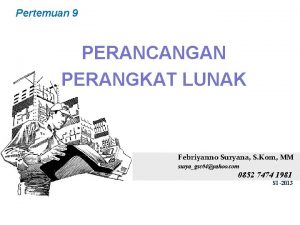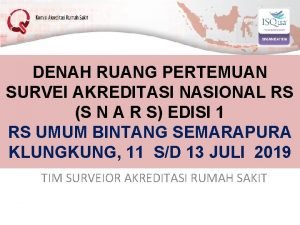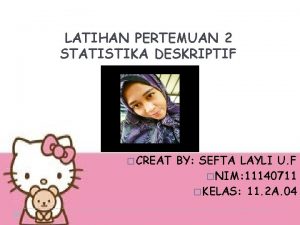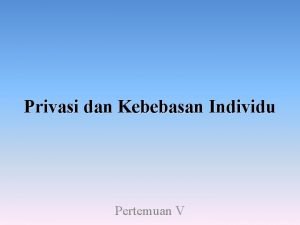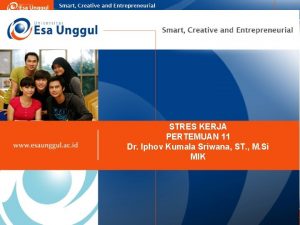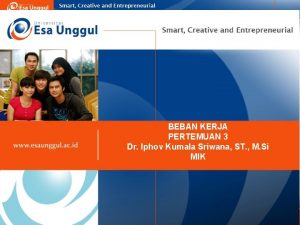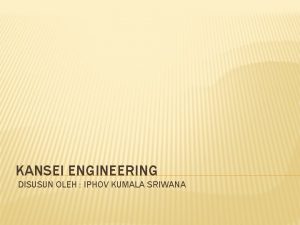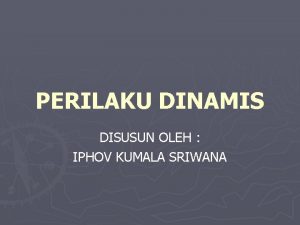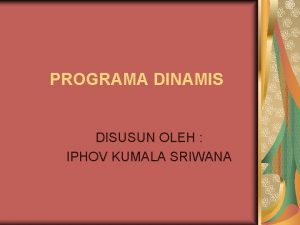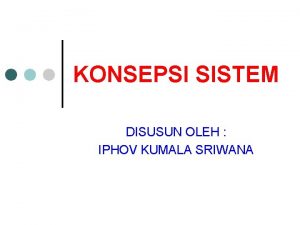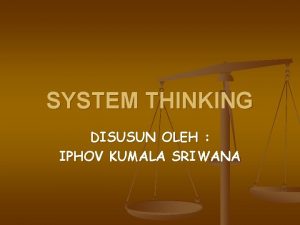Jod Design PERTEMUAN 2 Dr Iphov Kumala Sriwana
























- Slides: 24

Jod Design PERTEMUAN 2 Dr. Iphov Kumala Sriwana, ST. , M. Si MIK Iphov Kumala Sriwana

KEMAMPUAN AKHIR YANG DIHARAPKAN • Mahasiswa memahami konsep design kerja Iphov Kumala Sriwana

Division of labour • The division of labour is basically the separation of tasks in an industrial process, with the allocation of one worker to each specific task. • Adam Smith introduced the term in 1776, in his landmark publication An Inquiry into the Nature and Causes of the Wealth of Nations. • Smith observed the manufacture of pins; he found that the process was divided into 18 distinct operations which were performed in some cases by different workers; in others, one worker carried out two or three steps. • Examination of the work rate revealed that when each operation was given to a distinct worker, production was significantly greater than when a single worker performed more than one task. Iphov Kumala Sriwana

Division of labour • This led to Smith’s proposal of the following three advantages resulting from the division of labour; they were: 1. The development of a skill or dexterity when a single task is performed repetitively; 2. The saving of time normally lost in changing from one activity to the next, for example in putting down one set of tools and picking up another; 3. The invention of machines or tools to carry out tasks. it is easier to automate a short, simple task than a long and complex one. Iphov Kumala Sriwana

Scientific management • The main stimulus for scientific management came from Frederick Taylor with his publication The Principles of Scientific Management in 1911. • Taylor’s scientific management imperatives are to investigate the work situation and identify weaknesses, where and why is poor performance happening? Iphov Kumala Sriwana

Scientific management The ‘scientific’ title for this approach to management means placing emphasis on: 1. Data gathering and rational analysis; 2. Certain narrow assumptions about the objectivity of efficiency criteria; 3. The existence of direct, deterministic relationships between worker performance and incentive payments; 4. Consideration of the worker to some extent as a machine; 5. Selection of staff with characteristics to fit the job. Iphov Kumala Sriwana

Scientific management • Other contributors to the scientific management movement included Glibreth, Gantt, and Bedaux, all working in the United States. • Slack (2001) makes the observation that it is important to remember that scientific management is not particularly scientific as such, although it does take an investigative approach to improving operations. Two separate, but related, fields emerged (method study and work measurement) Iphov Kumala Sriwana

Work study comprises method study and work measurement Iphov Kumala Sriwana

Work study • Work study is a tool not only used in job design, but also as an improvement method in its own right. • It was developed and pioneered in the UK by the chemical company ICI in the late 1940 s. Iphov Kumala Sriwana

Method study • Method study is the systematic and critical examination of the ways of doing things in order to make improvements. • It seeks better ways of doing work and embraces equipment design and ergonomics as well as more subjective, psychological aspects of the person-job relationship. • Methods can be studied by observation, by interview, or by experiencing the job and then recording it using a chart of movement, such as a process chart or travel chart. Iphov Kumala Sriwana

Method study • There are three phases in method study applications: – The planning phase; – The analysis phase; – The implementation phase. Iphov Kumala Sriwana

Method study Planning phase • Carrying out a survey • Select the work to be studied • Define the scope of study Analysis Phase Record the present method Iphov Kumala Sriwana

Work measurement • Brooks (1984) identifies a three-stage procedure of work measurement. – The Analysis Stage – The Measurement Stage – The Synthesis Stage Iphov Kumala Sriwana

• The basic time is increased by other necessary factors (used to be called allowances) to become the standard time, where standard time is the time allowed for a job under specific circumstances. • Standard time includes factors which are required for recovery from fatigue, for relaxation, personal needs and others dependent on the nature of the job. Iphov Kumala Sriwana

Ergonomics • The Ergonomics Society of the UK describes ergonomics as being about ‘fit’: the fit being between people, the things they do, the objects they use and the environments in which they work, travel and play. • if a good fit is achieved, the stresses on people are reduced and when they are more comfortable, they can do things more quickly and easily with fewer mistakes Iphov Kumala Sriwana

Ergonomics • Ergonomics draws information from a variety of disciplines such as anthropology, biomechanics, physiology and psychology. • The word ‘ergonomics’ is derived from the Greek words ‘ergon’ (work) and ‘nomos’ laws. • It has been suggested by Dul & Weerdmeester (1988) that ergonomics aims to design appliances, technical systems and tasks in such away as to improve human safety, health, comfort and performance. • Ergonomics is concerned primarily with the physiological aspects of job design; that is, with the human body and how it fits into its surroundings. Iphov Kumala Sriwana

Ergonomics • Ergonomics is concerned with how the person interfaces with the physical aspect of his or her workplace, where the workplace includes tables, chairs, desks, machines, computers and so on. • ergonomics involves how a person interfaces with environmental conditions in his or her immediate working area. This means the ambient conditions in which the person works, such as temperature, lighting, noise levels and so on. Iphov Kumala Sriwana

Job enrichment • Herzberg and other theorists further describe how a concept entitled ‘vertical job enrichment’ can support positive attitudes toward work by reinforcing these motivation factors. • Vertical job enrichment (sometimes referred to as vertical loading factors) adds more authority, accountability, degree of difficulty and specialisation to an individual’s work. • By doing so, motivational factors such as responsibility, achievement, growth and learning, advancement and recognition are further developed. Iphov Kumala Sriwana

Job enrichment • Herzberg postulates that, by enriching a job, the individual increases his or her job satisfaction and thus positive motivation. • The re-design of jobs to increase motivation and performance should thus focus on motivation factors. Improvement in the hygiene factors will remove dissatisfaction but will not increase motivation and performance. Iphov Kumala Sriwana

Job enrichment • Herzberg developed a set of principles for the enrichment of jobs; these were: • Removing some controls while retaining accountability; • Increasing personal accountability for work; • Assigning each worker a complete unit of work with a clear start and end point; • Granting additional authority and freedom to workers; • Making periodic reports directly available to workers rather than to supervisors only; • The introduction of new and more difficult tasks into the job; • Encouraging the development of expertise by assigning individuals to specialised tasks. Iphov Kumala Sriwana

Job rotation • Job rotation moves employees from one task to another. • It distributes the group tasks among a number of employees. • Its roots are found in. Adam Smith’s division of labour theory. Iphov Kumala Sriwana

Job rotation • Job rotation and cross-training can benefit both employees and employers. • Workers learn new skills and face less boredom from performing similar tasks over and over. • Greater variety and a wide range of tasks make work more interesting and challenging. Iphov Kumala Sriwana

Job enlargement • Job enlargement (sometimes also referred to as ‘horizontal loading’). • However, by widening the range of tasks that need to be performed, hopefully the employee will experience less repetition and monotony than is common on production lines which rely upon the division of labour. • Job enlargement involves more autonomy and control for the worker. For example, if an employee normally assembles parts, the job may be enlarged to include new tasks such as work planning, inspection/quality control, or maintenance. • This method should add interest to the work but may or may not give employees more responsibility. Iphov Kumala Sriwana

Job enlargement • With job enlargement, the employee rarely needs to acquire new skills to carry out the additional task, and the motivational benefits of job enrichment are not usually experienced. • One important negative aspect is that job enlargement is sometimes viewed by employees as a requirement to carry out more work for the same amount of pay. • New jobs are also often only a marginal improvement in terms of the degree of repetition, the skill demands and the level of responsibility. • As a result, workers may not always respond positively to such change. • Job enlargement schemes may not be feasible e. g. in motor vehicle assembly, without a major change in the production facilities. Iphov Kumala Sriwana
 Iphov kumala sriwana
Iphov kumala sriwana Skema proses pemodelan
Skema proses pemodelan Serendipitas
Serendipitas Iphov kumala sriwana
Iphov kumala sriwana Iphov kumala sriwana
Iphov kumala sriwana Iphov
Iphov Iphov kumala sriwana
Iphov kumala sriwana Iphov kumala sriwana
Iphov kumala sriwana Jód vegyjel
Jód vegyjel Fluor chlor brom jod
Fluor chlor brom jod Tod fod jod
Tod fod jod Czy jod to substancja prosta
Czy jod to substancja prosta Jod stift
Jod stift Jod wikipedija
Jod wikipedija T3 thyrotoxicosis causes
T3 thyrotoxicosis causes Jód skupenstvo
Jód skupenstvo Tugas pertemuan 9 metode perancangan program
Tugas pertemuan 9 metode perancangan program Pertemuan antara sumbu datar dan sumbu tegak dinamakan
Pertemuan antara sumbu datar dan sumbu tegak dinamakan Pendekatan kontribusi adalah
Pendekatan kontribusi adalah Pertemuan multikultural
Pertemuan multikultural Denah ruang pertemuan
Denah ruang pertemuan Majas pleonasme
Majas pleonasme Tugas statistika pertemuan 2
Tugas statistika pertemuan 2 Pada pertemuan kali ini kita
Pada pertemuan kali ini kita Pertemuan ini
Pertemuan ini

